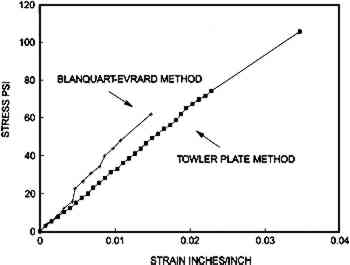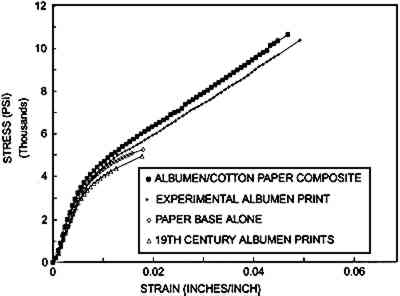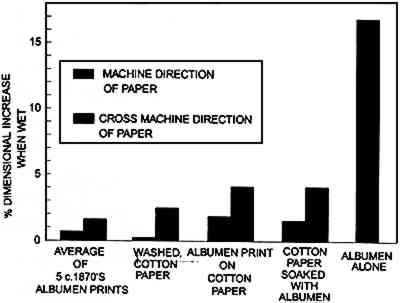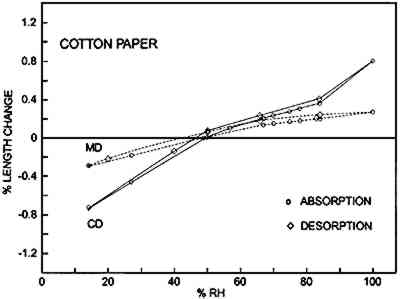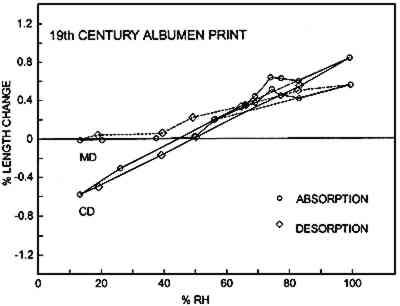PHYSICAL AND MECHANICAL PROPERTIES OF ALBUMEN PHOTOGRAPHSTIMOTHY VITALE, & PAUL MESSIER
3 RESULTS3.1 MECHANICAL ANALYSIS3.1.1 Equilibrium Stress-Strain of Unsupported Nonsensitized AlbumenAlbumen is soft with a modulus of 3,031–4,166 psi, moderately extensible with a 1.5–3.4% stretch, and very weak with a tensile strength of 62–105 psi. The albumen with microfissures and cracks is only slightly weaker than the crack-free albumen. Figure 3 shows averaged stress-strain curves from multiple individual unsupported albumen samples measured using the equilibrium stress-strain protocol, which features slow strain rate. The mechanical data are listed in table 1.
MECHANICAL PROPERTIES OF ALBUMEN PRINTS AND COMPONENTS Unexpectedly, the load at break and modulus for the two different samples (cracked and crack-free) is similar. The mechanical data for samples containing numerous small fissures were gathered from the Blanquart-Evrard method bars. Mechanical data gathered from the crack-free samples used the Towler plate method bars. The principal difference is that the crack-free bars stretch 3.4% prior to failure, while the precracked samples could only be stretched 1.5% before failure. 3.1.2 Physical Manipulation of Unsupported Nonsensitized AlbumenAlbumen is a light, lemon-colored, clear material. Upon handling, most observers 3.1.3 Ultrasonic Impediometry of Unsupported Nonsensitized AlbumenUsing 5 MHz ultrasonic impediometry to determine the shear modulus of Blanquart-Evrard method albumen, it was found that very high rates of strain increase stiffness, resulting in a Young's modulus of 1,270,000 psi (shear modulus = 477,000 psi) of the dry albumen. Although it is difficult to compare straining rates, 5 MHz ultrasonic impediometry (dynamic mechanical technique) is approximately 10 orders of magnitude faster than the equilibrium stress-strain protocol. Only one complete run is evaluated here, but three similar partial runs confirmed the magnitude of the modulus. 3.1.4 Equilibrium Stress-Strain of Prints, Paper, and CompositeFigure 4 shows a comparison of three averaged mechanical analyses using the equilibrium stress-strain protocol for the (1) three different 19th-century albumen photographs (one sample from each), (2) the unsized cotton paper, (3) the albumen print made for this experiment, and (4) albumen/paper composite.
From figure 4 it is evident that the curves for the uncoated paper base and the curves for the experimental albumen prints are dissimilar and that the experimental print is almost identical to the albumen/paper composite. The moduli of all of the samples are quite close, within 25%. The principal difference between the plots is that the paper base cannot carry a load beyond 5,220 psi. The addition of albumen to both the composite and the experimental print increases the ability of the paper base to stretch and carry a load. For the purpose of comparison: single cotton fibers stretch 20% and rupture at 50,000–100,000 psi (Vitale 1992a). The tensile strength of the experimental albumen print and that of the historical sample are very different, while their moduli are the same. The historical print behaves similarly to the uncoated cotton paper. The behavior of the albumen/paper composite made with nonsensitized albumen is almost identical to the experimental print. The albumen layer on the albumen print was sensitized. It appears that sensitization and the related “hardening” of the albumen component do not influence mechanical behavior significantly. 3.2 SWELLING WHEN WETFigure 5 shows the results of swelling in water. Unsupported albumen swells more than 17% when exposed to water; swelling above 17% could not be measured accurately. This behavior is designated by reporting the swelling as 17%+. Albumen prints show different behavior. The five historical samples swelled an average of less than 1% in the machine direction (MD) and just under 2% in the cross-machine direction (CD). The experimental print swelled nearly 2% MD and 4% CD. The albumen/paper composite had virtually the same response to water. The washed cotton paper had an increase of less than 0.5% MD and an increase of 2.75% CD. The differences between samples are obviously due to the addition of albumen to the paper. As with the mechanical testing results, the behavior of the composite samples is not dominated by the properties of either the paper base or by albumen, but by a combination of both.
3.3 MOISTURE SORPTION-DESORPTION BEHAVIOR OF ALBUMEN PRINTS AND COMPONENTS3.3.1 Size Changes
Figures 6a–d show the sorption-desorption behavior for all samples that are paper or have a paper base; three samples of each were
Table 2 is a summary of the results for this experiment. The values for the shrinkage of the experimental albumen print (n = 3) compare favorably to results of previous study (Messier and Vitale 1994), which shows that a group of 20 historical albumen prints shrank 0.19% MD and 0.35% CD. TABLE 2 AVERAGE DIMENSIONAL CHANGES MEASURED AT 50% RH AFTERDESORPTION FROM 100% RH 3.3.2 Moisture vs. Sorption-Desorption CurvesThe unsized cotton paper (fig. 6a) displays normal hysteresis behavior. It changes 0.5% MD and 1.6% CD. The albumen/paper composite (fig. 6b) displays very different behavior even though it is made using the same paper. At about 60% RH the CD curve shows that the sample stops increasing in length and does not resume normal behavior until approximately 80% RH. The behavior of the MD curve is also quite odd; it shows a shrinkage between 78% RH and 84% RH. The experimental albumen print (fig. 6c) also displays the odd behavior seen for the albumen/paper composite samples. In CD, the sample appears to stop increasing in length between 56% RH and 70% RH. The MD sample shrinks slightly between 75% RH and 78% RH. This type of discontinuous behavior is also exhibited in the adsorption phase of a single historical print (fig. 6d).
3.4 SORPTION-DESORPTION BEHAVIOR OF UNSUPPORTED, NONSENSITIZED ALBUMENThere is average 2% dimensional increase in the 10 unsupported, nonsensitized albumen chips when the relative humidity is increased
The albumen shrank 1.25% after one excursion from 50% RH to 85% RH and back to the initial RH 50%. On the second cycle the shrinkage did not occur. 3.5 EVIDENCE OF AN ALBUMEN/PAPER COMPOSITEFigure 8 is a scanning electron microscope micrograph showing a 19th-century albumen print in cross section. Note that a thin layer of uppermost paper fibers is fully permeated with albumen. Sizing appears to have restricted the penetration of liquid albumen during the albumen-coating process. |
